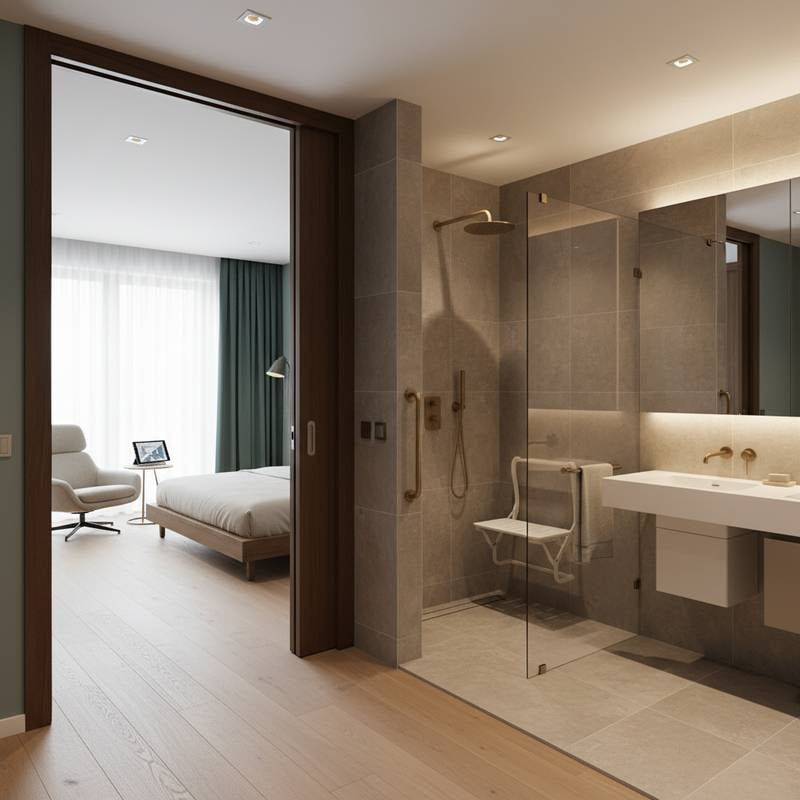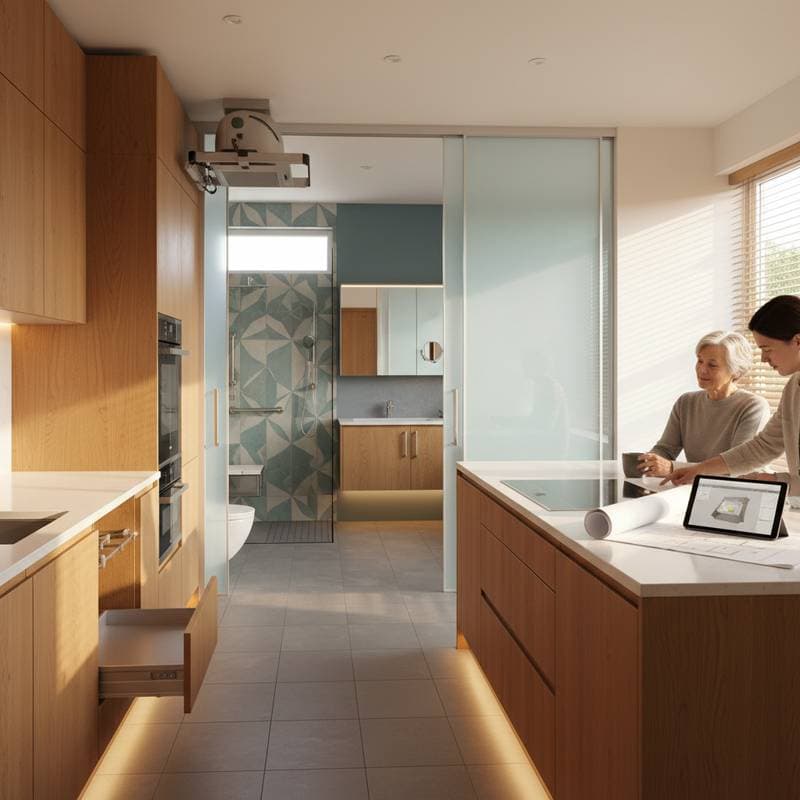2025 Universal Design Costs for Aging-in-Place
Universal design transforms a home into a space that accommodates residents of all ages and abilities. This approach emphasizes seamless accessibility, enhanced safety, and enduring comfort without relying solely on add-ons like grab bars or ramps. Homeowners pursuing aging-in-place modifications benefit from features that support independence over time. This guide details the principles of universal design, associated costs, project timelines, and practical implementation steps.
Cost and Time Estimates
Remodeling expenses for universal design fluctuate according to the project's scale, selected materials, and regional labor rates. Homeowners typically encounter these budget categories:
- Minor accessibility upgrades: $2,000 to $8,000
These include installing grab bars in bathrooms, replacing doorknobs with lever handles, applying non-slip mats or flooring treatments, and adding motion-activated lighting to hallways and stairwells. - Moderate remodels: $15,000 to $40,000
Such projects encompass widening interior doorways to 36 inches, converting tub-shower combinations into curbless, roll-in showers with fold-down seats, and installing height-adjustable kitchen sinks and countertops. - Full home conversions: $60,000 to $150,000 or higher
Comprehensive efforts involve reconfiguring entire kitchens with pull-out shelves and lower cabinetry, redesigning bathrooms for wheelchair maneuverability, adding exterior ramps with gentle slopes, and integrating stair lifts or platform elevators.
Labor and materials constitute the largest portion of expenditures. Contractors certified in accessibility standards command premium rates yet guarantee adherence to regulations like the Americans with Disabilities Act. Permits become necessary for alterations affecting load-bearing walls, plumbing systems, or electrical wiring; fees vary by municipality, often ranging from $200 to $1,500.
Project durations depend on complexity:
- DIY initiatives for basic updates span 1 to 4 weeks.
- Professional overhauls for extensive work extend 2 to 6 months, including planning and approvals.
These endeavors range from moderate to advanced difficulty, requiring familiarity with tools and safety protocols for optimal results.
Step-by-Step Implementation Guide
1. Assess Existing Conditions
Conduct a thorough walkthrough of the property to identify potential obstacles. Examine doorways narrower than 32 inches, elevated thresholds exceeding 1/2 inch, and bathrooms lacking sufficient turning radius for wheelchairs. Measure critical dimensions, such as hallway widths of at least 36 inches and countertop heights between 28 and 34 inches for seated use.
Document areas prone to hazards, including dimly lit corridors or glossy tile floors that promote slips. Compile a prioritized inventory of modifications to inform subsequent budgeting and design choices.
2. Develop the Design Plan
Focus initial efforts on high-traffic zones like entryways, kitchens, and primary bathrooms, where daily activities occur. Draft floor plans that facilitate unobstructed paths, incorporating 5-foot turning circles in key rooms and single-lever faucets for effortless operation.
Select robust, low-maintenance materials such as textured vinyl flooring with a coefficient of friction above 0.6 and matte-finish countertops resistant to stains. Balance immediate necessities, like threshold ramps, with forward-thinking elements, such as pre-wired outlets for future assistive devices.
3. Secure Permits and Gather Quotes
Consult the local building authority early to determine requirements for your proposed changes, such as engineering reviews for ramp installations. Solicit detailed bids from a minimum of three specialists in universal design, specifying material grades and installation methods.
Inquire about post-project warranties, typically covering workmanship for 1 to 5 years, and projected completion dates. Verify each contractor's credentials, including state licenses, liability insurance, and references from similar accessibility projects.
4. Prepare the Site
Relocate furnishings and personal items from affected areas to protect them from dust and disruption. Arrange alternative accommodations, such as staying with family, if essential spaces like the kitchen face prolonged inaccessibility.
Coordinate with professionals on utility interruptions, ensuring advance notice for water or electricity cutoffs. Establish clear pathways for workers, securing the site against unauthorized access and potential hazards.
5. Execute the Modifications
Commence with foundational adjustments, such as framing wider door openings or recessing light switches to 48-inch maximum heights. Proceed to safety installations, securing grab bars with 1x6-inch wooden backer boards behind drywall for stability.
Update surfaces by laying slip-resistant flooring with seamless transitions and integrating automatic door openers where feasible. Enhance visibility through layered lighting schemes, combining ambient overhead fixtures with focused task lights over workspaces.
Each phase advances mobility and minimizes injury risks, creating fluid navigation throughout the residence.
6. Perform Inspections and Testing
Evaluate the functionality of all elements, confirming that controls like thermostats remain within 15 to 48 inches from the floor for seated access. Test ramps for compliance, ensuring a maximum slope of 1:12 and handrails on both sides.
Navigate the space using simulated mobility challenges, such as wheeled carts, to detect any remaining barriers. Engage a certified inspector to validate code conformity, addressing issues like uneven flooring before final occupancy.
Addressing Common Challenges
Narrow doorways impeding mobility devices: Opt for slab replacements with pre-hung units featuring 2-inch extensions via pivot hinges, avoiding costly wall expansions.
Unstable grab bars: Bolster anchors by installing plywood blocking during initial framing, rated to support 250 pounds of dynamic load.
Shower drainage issues causing water accumulation: Regrade the pan to a consistent 1/4-inch-per-foot pitch, ensuring the linear drain aligns precisely with the lowest point.
Insufficient illumination in transitions: Incorporate LED strips along baseboards and photo-sensor nightlights that activate below 10 foot-candles.
Essential quality benchmarks include:
- Door clearances of 32 inches minimum net width.
- Floor level changes not surpassing 1/4 inch without beveling.
- Controls positioned 15 to 48 inches vertically.
- Bathroom floors draining efficiently without standing water.
Ongoing Maintenance Strategies
Properly executed universal design elements demand routine care to sustain performance.
Perform weekly cleaning on handrails using mild soap to preserve tactile feedback. Conduct monthly visual surveys of pathways, repairing cracks in ramps or loosening fixtures promptly.
Monitor electrical components quarterly, replacing bulbs to maintain 50 foot-candles in active areas. Expected durability varies:
- Structural supports like bars and rails: 10 to 20 years.
- Durable surfaces such as resilient flooring: 15 to 25 years.
- Hardware including levers and valves: 15 years minimum.
- Mechanical aids like lifts: 10 to 15 years with annual servicing.
Consistent upkeep preserves the investment and adapts to evolving requirements.
Strategies for Optimal Outcomes
Initiate with targeted interventions if funds constrain scope, prioritizing fall-prevention measures like edge contrasting in high-contrast paint. Incorporate visual cues, such as 70 percent color variance between adjacent surfaces, to aid depth perception.
Favor ergonomic controls, including touchless faucets and magnetic cabinet latches, for intuitive handling. Eliminate elevation changes by flush-mounting hardware, fostering hazard-free circulation.
Anticipate progression by reserving 60-inch corridors for potential equipment. These deliberate enhancements promote sustained autonomy, fortify security, and elevate daily living quality. Investing thoughtfully now averts reactive overhauls, cultivating an inclusive haven that endures alongside residents.











